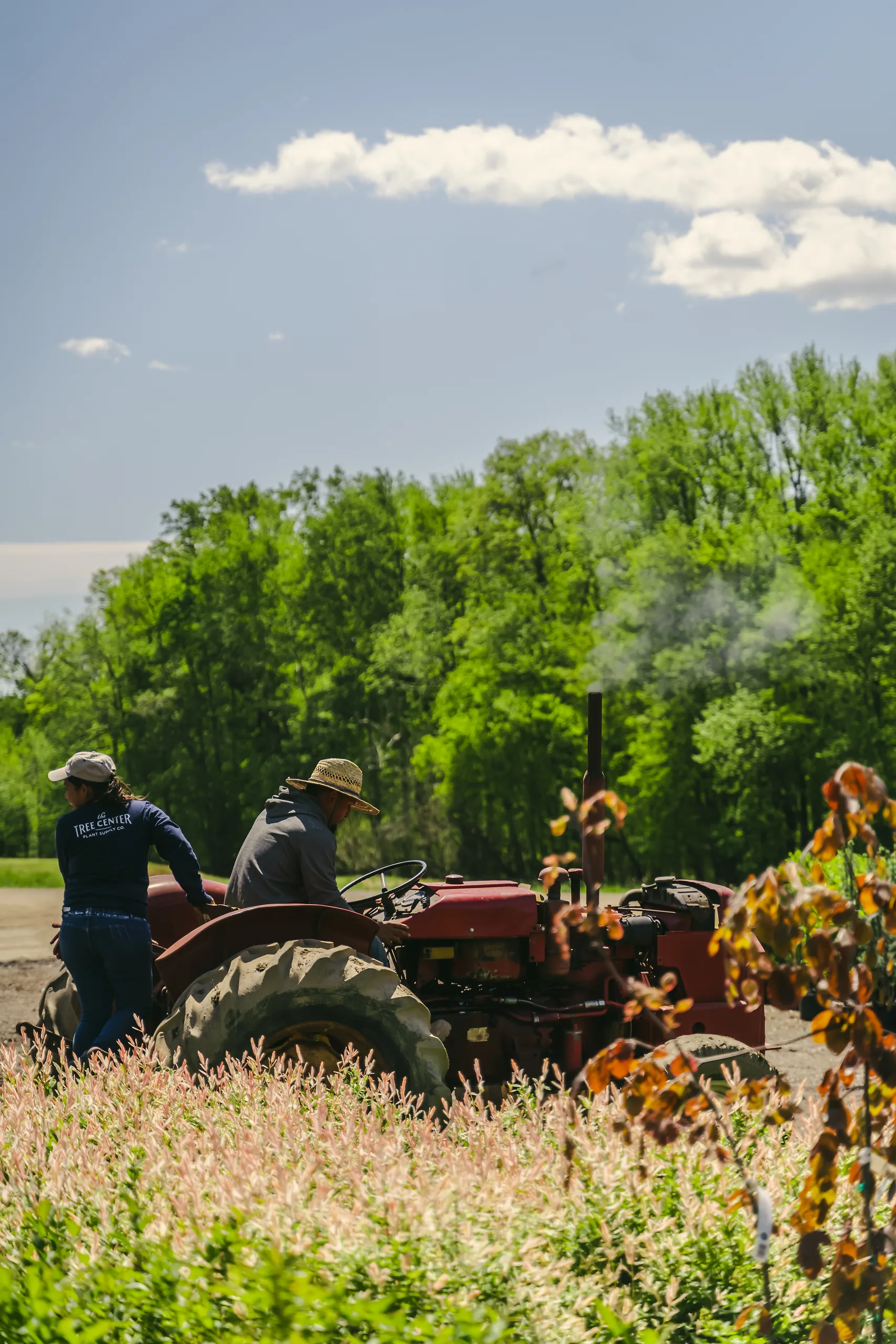
Written by s • How to Transplant Established Evergreen Trees
In a perfect world, every plant we put in the ground would be in exactly the right place, and stay there forever. Hah! Back in the real word, despite our best intentions, it doesn’t always work out that way. So we gardeners are from time to time – hopefully not too often – faced with the problem of needing to move an established plant. By ‘established’ I don’t mean something that has been there 20 years (although moving such a plant can still be possible) but the more usual situation of a plant that has been no more than about 5 years in the ground. The shorter the time since it was planted, the easier this job will be, but nothing is impossible, even with an really well-established plant.
So here you are, faced with moving an established evergreen. Maybe it’s a conifer, which could be anything from arborvitae (Thuja) to a spruce, a pine, a cedar or an cypress. Or maybe it’s a broad-leaf evergreen like a holly tree, a cherry laurel, a rhododendron, a southern magnolia or an olive tree. There is a long list of possibilities, but almost always the steps and issues are going to be the same.
Let’s Think About this Problem
Before ‘action’ comes ‘thought’, and understanding the issues that your evergreen is going to face when transplanted is going to help us come up with the best solutions. The main problem is this. The great thing about being a deciduous tree is that in winter you have no leaves, and your buds are usually covered with a water-proof coating of thick modified leaves (bud scales) and resins. An evergreen by definition has leaves all winter, and despite their small size and thick outer cuticle, they still lose moisture throughout the winter months. Even when it is well below freezing. That lost water has to be replaced, so the tree needs an active root system all the time, there is no real dormancy. Of course summer, with high temperatures speeding up evaporation, is going to be the worst possible time, and fragile new roots just aren’t going to keep up with the demands for water. But in winter too desiccation is a real risk.
Here is another thing to think about. You know those pictures of tree roots going deep down, like an upside version of the top part of a tree – pure fantasy. Almost all the roots of a tree of any kind are in the top 12 inches, or at most 2 feet of the soil.
So forget any idea you had of “digging a nice deep root ball to get all the roots”.
Ever seen a contractor using a tree spade to remove a tree, in a ball of soil that is about as deep as it is wide? Well the bottom half of that soil has almost no roots in it.
How to Solve this Problem and Safely Transplant Your Evergreens
The solution to this problem is a package of steps you need to take when moving that established evergreen. Ignore one and your chances of success can fall, maybe just a little bit, maybe a lot.
Step One – Transplanting Season
There are two seasons that experience has shown as the best times for evergreen transplanting. Both are ‘cusp’ points in the growing cycle – they are the times between hotter weather and colder weather, early spring and early fall. The day when the worst of winter is over, but plants are not yet sending out new shoots, and the period when the heat of summer has gone, but winter cold hasn’t yet begun to settle in. Exactly when that is for you will depend on your growing zone, and so will which one is best. The colder your zone, the more early spring becomes the better choice, the warmer your zone, the more early fall is best. If your winters are mild, then you can almost do it at any time between early fall and early spring, right through winter. So to put it simply:
- In Zones 3 and 4, transplant in early spring
- In zones 5, 6 and 7, transplant in spring or fall
- In zones 8 and 9, transplant anytime between early fall and early spring
- Try for fall planting if you usually have early, hot springs and hot, dry summers
- In all zones, have a window of several weeks for establishment before hard cold or significant heat arrive
Step 2 – Supplies
For this job you are going to need a sharp spade, preferably a narrow one with a flat back. Bring your sharp secateurs. You also need a roll of burlap, and some strong but flexible rope, either nylon or preferably of a natural material like jute or sisal. A strong tarpaulin sheet is also very useful for sliding a heavy root ball around
Step 3 – Preparation

The longer your tree has been in the ground, the more important some preparation becomes. In older times, when the pace of life was slower, it was advised to start several years ahead of time. Today it’s very unlikely you have that available, but if you have a very special specimen you want to move, that has been there more than 10 or 15 years, it would be best to try and prepare ahead. Here is how, but I recognize you probably can’t do all this.
In the fall (or spring), begin by digging a trench a spade wide around 50% of the tree – opposite quarters is best. Do it so the outer edge is at the drip-line – the point where the majority of branches spread out to. Enrich the soil with compost and put it back in the trench. The following fall, 12 months later, do the same thing with the 50% you didn’t do. The next fall the tree will be ready to transplant. By doing this you build a lot of roots close into the tree, which will go with it when it is transplanted, and give it a much better chance of survival.
I know, chances are you don’t have 3 years to do this! So at least, you certainly have time for this, before you do the actual digging:
- Soak the whole area deeply and slowly, well out past the drip-line. Do this several days before you dig, so the soil is moist but not wet and sticky
Step 4 – Start Digging
Now we are going to dig up the tree, creating a compact root-ball that can be moved to a new location. The last thing you want is all the soil falling off the roots. To calculate the size, allow 12 inches of diameter, that is, 6 inches either side of the trunk, for every 2 feet of height. For a very narrow, upright tree you could reduce that to as little as 8 inches. A root ball is surprisingly heavy, so although bigger would be better, we have to compromise.
It is often useful to tie up the branches to get them out of the way, so do that first.
Dig a trench right around the tree, in a circle, with the inner edge the size of the root-ball you want. As you dig the trench, trim the roots you encounter neatly, with a sharp flat spade. Hold it with the back against the ball, so as not to disturb that soil and loosen it.
Cut thicker roots with pruners, but if you are finding a lot of thick roots you need to make the ball a bit wider. ‘Thick’ would be more than ½ inch in diameter. If it is just a few, with plenty of small ones too, you are fine. Go down at a slight angle inwards until you stop seeing a lot of roots.
Now start digging sharply under the tree until it is resting on a thin column of soil. At no time poke or pry at that ball of earth – you want it solid and firm. Do all the work in the trench around it.
- Neat, rounded root ball only as deep as the area of visible roots, plus the section sloping underneath.
Step 5 – Prepare the Root-Ball
If your tree is small, and the root ball only a foot or so across, you might be able to just slide a plastic sheet under it and carry it carefully to its new home. If it’s heavy, though, it could easily collapse. For a larger ball, and to be safe, take a piece of that burlap and wrap it around the root-ball. Don’t try to slide it completely underneath, just reduce that column of soil to something as narrow as possible, without letting the tree fall over. Once you have it firmly wrapped around, make a circle of rope that sits on the top, half way to the outer edge of the ball. Tie another circle around the base, big enough to be able to get your hand into. Now tie one end of a long piece of rope to the top circle, pull it down and through the bottom one, and back up again. Continue around the root-ball in this fashion, tightening the rope as you go, until you have laced up the whole root ball as tightly and neatly as you can.
- Aim for a tight ball that isn’t going to fall apart when you start moving it
Step 6 – Moving Your Tree
Once you have it wrapped, cut through that soil column and tuck the edges of the burlap underneath the tree. Now you can drag, push, or lift the tree out of the hole. That tarpaulin will be very useful at this stage.
- Take your time and don’t put your back out
Step 7 – Planting
You can leave your tree wrapped and ready for a few days if you need to. Be careful it doesn’t dry out if it is more than just a day or two – spray with water as needed.
Dig a hole the depth of the root ball, but significantly wider – at least a foot wider on both sides. Check out this picture for a perfect planting hole. If your soil is poor, blend some compost into the soil you removed. Start refilling the hole before removing any of the rope or burlap. Do that gradually as you replace the soil, firming it down to support the ball.
This is where using natural jute and natural rope is great, because if you don’t take it all out it will just rot into the ground. If you are forced to use synthetic burlap and rope, try to get as much as possible out of the hole as you go – just cut it into small pieces. Always cut the rope where you can and remove the upper parts of the burlap. This is a judgement call – do as much as you can without letting the ball collapse.
Step 8 – Finishing your Evergreen Move
Before all the soil is back, take your hose and really fill that hole with water. Let it all drain away and come back later to replace the last of the soil. This is much better than filling the hole completely and then trying to water it. During the first couple of seasons, pay special attention to keeping your tree well-watered. The use of anti-desiccants during the first couple of winters is also a great thing to do if you live in a zone where the ground freezes solid in winter.
There you go, successful transplanting.





